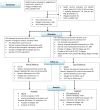Effect of Village Health Team Home Visits and Mobile Phone Consultations on Maternal and Newborn Care Practices in Masindi and Kiryandongo, Uganda: A Community-Intervention Trial
- PMID: 27101379
- PMCID: PMC4839625
- DOI: 10.1371/journal.pone.0153051
Effect of Village Health Team Home Visits and Mobile Phone Consultations on Maternal and Newborn Care Practices in Masindi and Kiryandongo, Uganda: A Community-Intervention Trial
Abstract
Introduction: The World Health Organisation recommends home visits conducted by Community Health Workers (in Uganda known as Village Health Teams--VHTs) in order to improve maternal and newborn health. This study measured the effect of home visits combined with mobile phone consultations on maternal and newborn care practices.
Method: In a community intervention trial design 16 health centres in Masindi and Kiryandongo districts, Uganda were randomly and equally allocated to one of two arms: control and intervention arms. Eight control health centres received the usual maternal and newborn educational messages offered by professional health workers and eight intervention health centres that received an intervention package for maternal care and essential newborn care practices. In the intervention arm VHTs made two prenatal and one postnatal home visit to households. VHTs were provided with mobile phones to enable them make regular telephone consultations with health workers at the health centre serving the catchment area. The primary outcome was health facility delivery. Other outcomes included antenatal attendances, birth preparedness, cord and thermal care and breastfeeding practices. Analysis was by intention-to-treat.
Results: A total of 1385 pregnant women were analysed: 758 and 627 in the control and intervention arms respectively. Significant post-intervention differences were: delivery place [adjusted Odds Ratio aOR: 17.94(95%CI: 6.26-51.37); p<0.001], cord care [aOR: 3.05(95%CI: 1.81-5.12); p<0.001] thermal care [aOR: 7.58(95%CI: 2.52-22.82); p<0.001], and timely care-seeking for newborn illness [aOR: 4.93(95%CI: 1.59-15.31); p = 0.006].
Conclusion: VHTs can have an effect in promoting proper cord and thermal care for the newborn and improve timely care-seeking for health facility delivery and newborn illness, because they could answer questions and refer patients correctly. However, VHTs should be supported by professional health workers through the use of mobile phones.
Trial registration: ClinicalTrials.gov NCT02084680.
Conflict of interest statement
Figures
References
-
- WHO ICM (2014) Trends in Maternal Mortality: 1990 to 2013’, estimates. WHO, UNICEF, UNFPA, the World Bank and the United Nations Population Division, Geneva, 2014.
-
- UNICEF (2014) Committing to Child Survival: A Promise Renewed. United Nations Children’s Fund (UNICEF), September 2014 3 United Nations Plaza, New York, NY.
-
- UDHS and ICF (2012) Uganda Demographic and Health Survey 2011. Uganda Bureau of Statistics Kampala, Uganda MEASURE DHS ICF International Calverton, Maryland, USA.
-
- Jones G S R, Black RE, Bhutta ZA, M SS., Bellagio CSSG (2003) How Many Child Deaths Can We Prevent This Year? Lancet 362: 65–71. - PubMed
Publication types
MeSH terms
Associated data
LinkOut - more resources
Full Text Sources
Other Literature Sources
Medical


